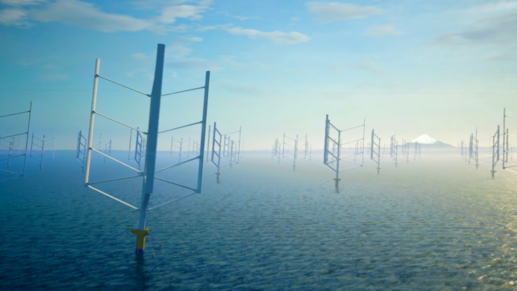Press Release
Conclusion of joint research agreement for “offshore small demonstration study of next-generation (floating axis) wind turbine” ~Development of domestic floating wind turbine that decreases cost for offshore wind power generation~
May 30, 2023
Electric Power Development Co., Ltd.
Tokyo Electric Power Company Holdings, Inc.
Chubu Electric Power Co., Inc.
Kawasaki Kisen Kaisha, Ltd.
Albatross Technology Inc.
Electric Power Development Co., Ltd. (“J-POWER” (Note 1)), Tokyo Electric Power Company Holdings, Inc. (“TEPCO HD” (Note 2)), Chubu Electric Power Co., Inc. (“Chubu Electric Power” (Note 3)), Kawasaki Kisen Kaisha, Ltd. (“Kawasaki Kisen” (Note 4)) and Albatross Technology Inc. (“Albatross” (Note 5)) have concluded a joint research agreement for the “offshore small demonstration study of next-generation (floating axis) wind turbine” (the Demonstration Study).

Image of floating axis wind turbine wind farm (source: Albatross Technology Inc.)
The Japanese government has a policy in place to maximize the introduction of renewable energy to realize carbon neutrality in 2050. Offshore wind power generation in particular is considered a trump card to make renewable energy the main source of power, as it can be introduced in large volumes and reduce cost and economic ripple effects are expected. In Japan, where shallow waters are scarce, there is increasing expectation for floating offshore wind power generation which has much room for introduction in deep waters, but large cost reduction through technological development is essential for its proliferation. Additionally, high economic ripple effects are expected by increasing the domestic production rate in manufacturing.
Against such backdrop, the five companies will jointly manufacture a small experimental floating axis wind turbine (20kW level) in the Demonstration Study, as a next-generation wind turbine that is expected to reduce cost and increase domestic production rate.
The floating axis wind turbine (FAWT) has the concept of supporting the vertical axis wind turbine with a “rotating” cylindrical floating body. Its major characteristics are as follows.
【Cost reduction】
- Since 20-degree tilt is allowed at maximum output, due to its characteristic of power generation performance not being easily degraded even when tilted, the floating body can be downsized, which will drastically reduce equipment costs.
- The wind turbine part can be manufactured at a low cost due to continuous pultrusion molding of carbon composite materials (CFRP) (Note 6).
- Maintenance and operation costs are also expected to be drastically reduced, by utilizing the characteristics of a vertical axis wind turbine for which the generator and other major components are installed near the sea surface.
【Increase of domestic production rate】
- Since wind turbine blades can be split and manufactured lengthwise in the same cross-sectional shape, there is no need for a large-scale manufacturing plant. Since it can also be easily transported, it is a design suited for manufacturing in Japan.
- Japanese companies account for 80% of the share of carbon fiber which is the raw material for carbon composite materials used for the wind turbine part.
J-POWER, Graduate School of Engineering of Osaka University and Albatross jointly promoted initial studies for the floating axis wind turbine. We will now go on to the next step for the Demonstration Study in a new framework. In the Demonstration Study, small experimental floating axis wind turbines will be installed in actual sea areas in Japan to confirm the validity of the analysis and design methods, which will lead to an offshore demonstration project for a larger unit (MW level).
We five companies will use our knowledge to jointly develop the floating axis wind turbine, which is expected to become a game changer for floating offshore wind power generation, thereby aiming to make offshore wind power generation the main source of power and contributing to the realization of a carbon neutral society.
(Aim of participating companies)
|
J-POWER, TEPCO HD, Chubu Electric Power |
Develop promising technologies for floating offshore wind power generation to expand introduction of renewable energy and contribute to the realization of a carbon neutral society. |
|---|---|
|
Kawasaki Kisen |
Support the commercialization of a new floating offshore wind turbine by providing the company’s knowledge as the Ship Safety Act will be applied to floating offshore wind turbines, and contribute to decarbonization of the society by utilizing knowledge gained from the study in future offshore wind power support vessel business. |
|
Albatross |
Commercialize innovative floating offshore wind turbines and widely spread them in Japan and overseas. |
(Cooperating organizations)
The Graduate School of Engineering of Osaka University will continue to provide guidance on sway analysis technology, and the Innovative Composite Materials Research and Development Center (ICC) (Kanazawa Institute of Technology) will provide guidance on molding technology of carbon composite materials. We will collaborate with Fukui Fibertech Co., Ltd. (Aichi Prefecture) for the wind turbine part and with MIRAI SHIPS INC. (Miyagi Prefecture) for the floating body part.
(Note 1) Electric Power Development Co., Ltd. (Headquarters: Chuo-ku, Tokyo; Representative Director President: Toshifumi Watanabe)
(Note 2) Tokyo Electric Power Company Holdings, Inc. (Head Office: Chiyoda-ku, Tokyo; Representative President: Tomoaki Kobayakawa)
(Note 3) Chubu Electric Power Co. (Head Office: Nagoya City, Aichi; President and Director: Kingo Hayashi)
(Note 4) Kawasaki Kisen Kaisha, Ltd. (Head Office: Chiyoda-ku, Tokyo; Representative Director and President: Yukikazu Myochin)
(Note 5) Albatross Technology Inc. (Head Office: Chuo-ku, Tokyo; Representative Director: Hiromichi Akimoto)
(Note 6) Molding method that solidifies resin and fiber while pulling them through a mold, and continuously outputs members with a fixed cross-section



